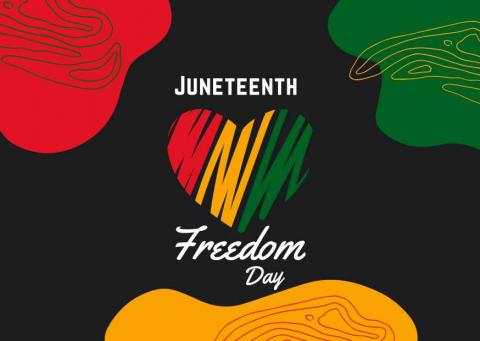
Juneteenth has evolved to be a celebration of freedom, a time of reflection on our history, and a time for education on civil rights and racial inequality. Originally, it was a celebration of the specific date that the news of emancipation reached the last enslaved African Americans in Galveston, Texas, on June 19, 1865.
The Emancipation Proclamation, issued by President Abraham Lincoln on January 1, 1863, declared all enslaved people in Confederate territory to be emancipated. The Emancipation Proclamation did not free enslaved people in “free states” just Confederate territories. The Civil War did not end until the Spring of 1865 with the surrender of Confederate General Robert E. Lee to Union General Ulysses S. Grant on April 9, 1865, and the final surrender of Confederate troops in Galveston on June 2, 1865.
Missouri was a border state, a state that allowed slavery, but remained in the Union, so the Emancipation Proclamation did not apply to it. It wasn’t until January 11, 1865, that Missouri abolished slavery by passing an ordinance at the 1865 Constitutional Convention. This is the date known as Emancipation Day in Missouri. Charles Drake, one of the Law Library Association founders, served as Vice-President of the 1865 state constitutional convention.
Before Emancipation Day in Missouri, some African Americans petitioned the courts for their freedom. In 1824 Missouri enacted a law that allowed enslaved people to sue for their freedom in certain situations. These “freedom suits” were not easy. The law required the petitioning person to prove that they were already a free person of color and that they were being abused. The burden of proof was upon the petitioner.
Over 300 enslaved persons brought Freedom Suits between 1812 and 1865, but less than half were successful. The suits were usually based on one of three theories: 1) that the petitioner was taken to a state or territory where slavery was not allowed; 2) that the petitioner was born to a mother who was not legally enslaved; and 3) that the petitioner was being wrongly enslaved after being legally freed by will or purchase.
To learn more about the Freedom Suits, please use the following resources:
- Freedom Suits Memorial Foundation website: https://stlfreedomsuits.org/the-plaintiffs/
- The Missouri State Archives' African American History Initiative https://www.sos.mo.gov/archives/education/aahi/beforedredscott/history_freedomsuits
- In the Shadow of Dred Scott: St. Louis Freedom Suits and the Legal Culture of Slavery in Antebellum America by Kelly Kennington
The Law Library Association will be hosting an exhibit in the fall on the Freedom Suits. https://llastl.org/slavery-freedom-suits
Juneteenth has evolved to be a celebration of freedom, a time of reflection on our history, and a time for education on civil rights and racial inequality. Originally, it was a celebration of the specific date that the news of emancipation reached the last enslaved African Americans in Galveston, Texas, on June 19, 1865.
The Emancipation Proclamation, issued by President Abraham Lincoln on January 1, 1863, declared all enslaved people in Confederate territory to be emancipated. The Emancipation Proclamation did not free enslaved people in “free states” just Confederate territories. The Civil War did not end until the Spring of 1865 with the surrender of Confederate General Robert E. Lee to Union General Ulysses S. Grant on April 9, 1865, and the final surrender of Confederate troops in Galveston on June 2, 1865.
Missouri was a border state, a state that allowed slavery, but remained in the Union, so the Emancipation Proclamation did not apply to it. It wasn’t until January 11, 1865, that Missouri abolished slavery by passing an ordinance at the 1865 Constitutional Convention. This is the date known as Emancipation Day in Missouri. Charles Drake, one of the Law Library Association founders, served as Vice-President of the 1865 state constitutional convention.
Before Emancipation Day in Missouri, some African Americans petitioned the courts for their freedom. In 1824 Missouri enacted a law that allowed enslaved people to sue for their freedom in certain situations. These “freedom suits” were not easy. The law required the petitioning person to prove that they were already a free person of color and that they were being abused. The burden of proof was upon the petitioner.
Over 300 enslaved persons brought Freedom Suits between 1812 and 1865, but less than half were successful. The suits were usually based on one of three theories: 1) that the petitioner was taken to a state or territory where slavery was not allowed; 2) that the petitioner was born to a mother who was not legally enslaved; and 3) that the petitioner was being wrongly enslaved after being legally freed by will or purchase.
To learn more about the Freedom Suits, please use the following resources:
- Freedom Suits Memorial Foundation website: https://stlfreedomsuits.org/the-plaintiffs/
- The Missouri State Archives' African American History Initiative https://www.sos.mo.gov/archives/education/aahi/beforedredscott/history_freedomsuits
- In the Shadow of Dred Scott: St. Louis Freedom Suits and the Legal Culture of Slavery in Antebellum America by Kelly Kennington
- The Law Library Association will host an exhibit in the fall on the Freedom Suits. https://llastl.org/slavery-freedom-suits
